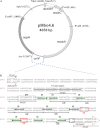Molecular characterization of plasmid pMbo4.6 of Moraxella bovis ATCC 10900
- PMID: 23129346
- PMCID: PMC3557383
- DOI: 10.1007/s00284-012-0257-6
Molecular characterization of plasmid pMbo4.6 of Moraxella bovis ATCC 10900
Abstract
We report the characterization of a small cryptic plasmid unlike any previously described from Moraxella bovis ATCC 10900, a Gram-negative bacterium belonging to the family Moraxellaceae. The complete nucleotide sequence of the plasmid pMbo4.6 was determined. The plasmid was analyzed and found to be 4658 in size with a G+C content of 38.6 mol %. Computer analysis of the sequence data revealed four major open reading frames encoding putative proteins of 10.1 (ORF1), 64.2 (ORF2), 45.7 (ORF3), and 12.1 kDa (ORF4). ORF1 and ORF2 encode proteins that show a high level of amino acid sequence similarity (44 %) with some mobilization proteins. ORF3 encodes a protein showing a relatively high amino acid sequence similarity (about 40 %) with several plasmid replication initiator proteins. Upstream of ORF3, a 320-bp intergenic region, constituting the putative origin of replication that contained an AT-rich region followed by four direct repeats, was identified. This set of repeated sequences resembles iteron structures and plays an important role in the control of plasmid replication by providing a target site for the initiation of transcription and replication factors (IHF and RepA). Several palindromic sequences, inverted repeats, and hairpin-loop structures, which might confer regulatory effects on the replication of the plasmid, were also noted. ORF4 encodes an uncharacterized protein, conserved in bacteria, belonging to the DUF497 family. Sequence analysis and structural features indicate that pMbo4.6 replicates by a theta mechanism.
Figures





Similar articles
-
Molecular characterization of plasmid pMoma1of Moraxella macacae, a newly described bacterial pathogen of macaques.Folia Microbiol (Praha). 2015 May;60(3):235-9. doi: 10.1007/s12223-014-0364-9. Epub 2014 Nov 15. Folia Microbiol (Praha). 2015. PMID: 25398380
-
Sequence analysis of plasmid pKJ50 from Bifidobacterium longum.Microbiology (Reading). 1999 Mar;145 ( Pt 3):585-592. doi: 10.1099/13500872-145-3-585. Microbiology (Reading). 1999. PMID: 10217492
-
Analysis of the replication region of the cryptic plasmid pHE1 from the moderate halophile Halomonas elongata.Mol Gen Genet. 1999 Jun;261(4-5):851-61. doi: 10.1007/s004380050029. Mol Gen Genet. 1999. PMID: 10394923
-
Genetic organization of the Francisella plasmid pFNL10.Plasmid. 2001 Nov;46(3):210-22. doi: 10.1006/plas.2001.1548. Plasmid. 2001. PMID: 11735370
-
Twenty years of the pPS10 replicon: insights on the molecular mechanism for the activation of DNA replication in iteron-containing bacterial plasmids.Plasmid. 2004 Sep;52(2):69-83. doi: 10.1016/j.plasmid.2004.06.002. Plasmid. 2004. PMID: 15336485 Review.
Cited by
-
Characterization of a Cryptic and Intriguing Low Molecular Weight Plasmid.Curr Microbiol. 2016 Mar;72(3):351-6. doi: 10.1007/s00284-015-0959-7. Epub 2015 Dec 15. Curr Microbiol. 2016. PMID: 26670037
-
Molecular characterization of plasmid pMoma1of Moraxella macacae, a newly described bacterial pathogen of macaques.Folia Microbiol (Praha). 2015 May;60(3):235-9. doi: 10.1007/s12223-014-0364-9. Epub 2014 Nov 15. Folia Microbiol (Praha). 2015. PMID: 25398380
References
-
- Bartosik D, Baj J, Sochnacka M, Piechucka E, Wlodarczyk M. Molecular characterization of functional module of plasmid pWKS1 of Paracoccus pantotrophus DSM 11072. Microbiology. 2002;14:2847–2856. - PubMed
Publication types
MeSH terms
Substances
Associated data
- Actions
LinkOut - more resources
Full Text Sources
Molecular Biology Databases

